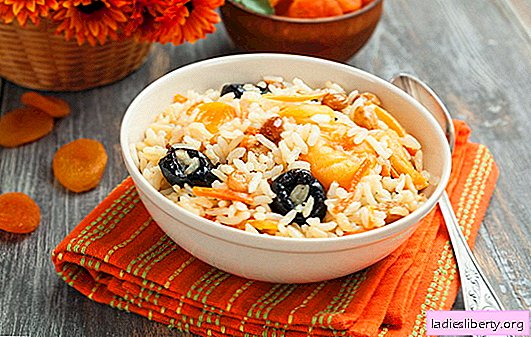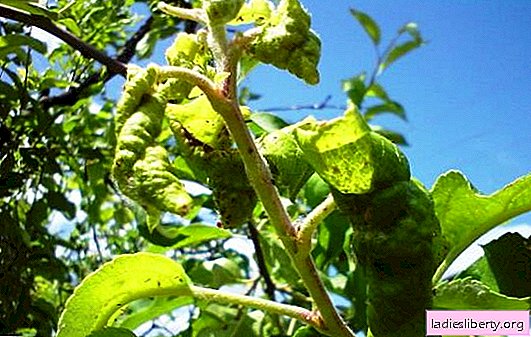
Did Cyrus II the Great know that the Persian Kingdom would disappear, and the pilaf prepared by his soldiers on campaigns would become the property of mankind?
But it is possible that this dish first appeared at the court of the Chinese emperors.
Let archaeologists or historians understand the origin of the sweet pilaf - try to understand the variety of its recipes and the art of "plovovanie".
Sweet pilaf - basic technological principles
Of the set of dried fruits, nuts, honey and rice, of course, pilaf can be obtained, provided that the cook knows the only main secret of any pilaf - crumbly rice.
Choose the right kind of rice. The less starch in it, the better. That muddy water that drains when washing the grain is a starch solution. Starch - these are carbohydrates that nutritionists together call the main threat to harmony. By the way, Indian housewives are advised to wash rice with purified water. They have special Ayurvedic knowledge of roofing felts, roofing felts are simply reinsured - it is unknown. But, it seems, a share of common sense is present in this: water containing bleach or heavy metal impurities, soaked in rice grains, will not add health. Let us listen to the opinions of wise Indian women.
What else? In those countries where pilaf first appeared, there is a rule of compatibility of taste, and the cook who knows how to achieve the same consistency of all the ingredients of the dish, as well as the equal presence of the main tastes: sweet, bitter, salty and sour, is considered a real master.
The last secret: do not think that sweet pilaf cannot be spicy. This is a fallacy that ancient Persian cookbooks refute.
By going to the kitchen with the recipes below, you can verify this personally.
Recipe 1. Armenian cuisine about sweet pilaf: "Hapama" or "Ararat"
The festive dish is a very tasty and healthy pilaf, just a "vitamin kick". Somewhat reminiscent of millet porridge with milk in Russian cuisine. Not a single Armenian wedding is complete without this sweet pilaf in a pumpkin, symbolizing the wish of a “sweet” life to newlyweds. Without pumpkin, this dish is served at any festive table.
The amount of ingredients depends on the size of the pumpkin. Big family - a big pumpkin. It is important to consider that in the process of cooking and stewing the cereal increases in volume by 2.5-3 times; dried fruits - 1.5-2.5 times. You can cook without pumpkins, in pots in the oven - in this case, improvise with the amount of ingredients to your liking.
Ingredients:
An Apple
Butter
Carrot
Raisins
Dried apricots
Pumpkin
Rice
Prunes
Cinnamon
Cooking:
After choosing a pumpkin, wash it, on the side of the tail, cut off the makeshift lid at the natural pot, from the most environmentally friendly and edible material. You can even cut off with a curly knife to practice at the same time in the art of carving. Remove the seeds and part of the pulp with a spoon. Wash and dry the seeds: pumpkin seeds will always come in handy, and the pulp will "participate" in the preparation of sweet pilaf. Oil the pumpkin inside. Creamy taste is the best option, if you do not think about calories for a while.
Wash and fry dried fruits with boiling water so that you can immediately see how much they will increase in size and determine how much to add to the pilaf.
Rice, previously aged in cold water, cook until half cooked, salted water. After cooking, wash it with cold water, you can from the tap, throwing it through a sieve or colander.
Free the apples from the core and cut into small cubes with the skin: a rare case when you can save a huge amount of vitamins contained in the apple skin without losing the softness of the consistency.
In one dish, collect all the prepared ingredients, add cinnamon. Sweeten or acidify if you want. Stir and stuff the pumpkin, but not tightly and not to the brim. Wrap the fruit in foil and bake at 200Ϲ. Time also depends on the size of the pumpkin.
Recipe 2. Indian traditions in sweet pilaf: "Mita Pilaav" - risotto with sweet saffron
This is a traditional recipe for North India. In the homeland of pilaf, they know a lot about rice and sweets, famous all over the world. Do not be surprised at the presence of mustard in the composition of the ingredients: in addition to the spicy taste of the sweet dish, mustard is an antiseptic, which for Indian cuisine, developed in a humid and hot climate, is a harsh vital necessity, allowing such sharp additives to fight harmful organisms that multiply rapidly in favorable for them conditions. In general, in India it is not customary to keep the remaining dinner or breakfast in the refrigerators - this is thrown out for reasons of food safety. But an exception was made for this pilaf, taking into account the method of preparation and tightness of the package: a very remarkable detail - pilaf is packaged in portions, in foil, like candy. That is, at any time, if desired, it can also be heated in portions in the oven - and enjoy your meal!
Ingredients:
Basmanti 200 g
Sugar 180 g
Pistachios, cashews, almonds (chips) 300 g
Oil ("Ghee") 150 g
Raisins 250 g
Dry mustard
Saffron 1 g
Cardamom 2-3 g
Clove
Cooking:
Indian housewives are advised to wash rice with purified water. Wash and drop it in boiling, slightly salted water to boil until half cooked, then add ghee and sugar, cloves, saffron and cardamom, half the nuts. After ten minutes, remove from heat, cool. Grease the prepared sheets of foil with oil, sprinkle with nuts mixed with mustard (use the rest). Combine the cooked rice, pre-washed and steamed raisins in one container, mix and place in portions on sheets of foil, roll with sweets and warm before serving.
Recipe 3. Ancient Persian recipes for sweet pilaf in Iranian cuisine: sweet pilaf with oranges and cherries
If someone knows a lot about pilaf, then these are the direct heirs of the ancient Persian cuisine - Iranians. They believe that sweet pilaf is not only a dessert after dinner, and it can be a full-fledged main course if you cook rice not only with berries or fruits, but also with chicken breast. There is something in it! Please note that such a rare combination of ingredients is completely balanced from the point of view of modern ideas about proper and healthy nutrition: fruits containing ascorbic acid stimulate appetite and at the same time promote digestion of the meat component, and the neutral taste of chicken breast, often used in modern kitchens for salads, harmoniously fits into the picture "sweet pilaf".
Ingredients:
Dried cherry, pitted 200 g
Oranges 400 - 500 g
Basmanti 0.5 kg
Muscat 10 g
Clove 3 g
Cardamom 5 g
Saffron, dried 2 g
Onion, red 150 g
Carrot 250 g
Pistachios 50 g
Almonds 100 g
Sugar 0.5 kg
Pepper 10 g
Sesame oil (available options) 150 ml
Salt
Chicken Breast 1.5 kg (or more)
Cooking:
Choose red oranges, small sizes. The preparation of this pilaf requires a long preliminary preparation. Oranges in pilaf are laid together with the peel, and therefore they need to be pre-processed the day before. Wash the fruits, at least a day before starting to cook pilaf. Pour boiling water at least three times, then immediately immerse them in ice water to remove the bitterness. Boil 300 ml of water, adding sugar to it, boil the syrup, which you need to pour the oranges and leave them in the syrup for at least 10-12 hours.
Wash the chicken breast by drying with a napkin, fry with finely diced carrots and onions. Season with salt, ground spices.
Prepared rice (washed and aged in cold water for 2 hours), transfer to a deep cast-iron cookware, preheating the oil in it. After 10 minutes, pour the brewed saffron, put the cherry, chopped nuts. After another ten minutes, put the pieces of the fried breast, pour them with rice and orange syrup. If necessary, add hot boiled water and simmer slowly until rice is cooked, covered with a lid. Before serving, set the meat aside to lay it on a dish over rice. Garnish with pilaf slices of oranges.
Recipe 4. Sweet pilaf with quail and cherry
I must admit that the art of cooking pilaf in the Ancient Persian Kingdom is so impressive that it is impossible to abandon their own new ideas and representatives of the East European cuisine.
Ingredients:
Quail 3 pcs.
Steamed rice 400 g
Cherry, fresh or frozen 200 g
Onion 150 g
Sugar 250 g
Water 1.5 L
Salt
Muscat 10 g
Black pepper 15 g
Dry red wine 200 ml
Ginger, fresh 30 g
Bay leaf 5 g
Allspice 3-4 g
Clove 2 g
Almonds 100 g
Garlic 40 g
Kiwi 150 g
Celery and parsley roots - 50 g each
Oil (for frying) 200 ml
Cooking:
Wash and dry the gutted quail carcasses with napkins. Cut them lengthwise, in half, lay the inside on a work board and slightly beat off. Rub with a mixture of freshly ground salt. Grind one kiwi fruit, add 100 ml of wine, bay leaf, grated roots of ginger, celery and parsley to it. Put the prepared carcasses in a plastic bag, pour in the prepared mixture and leave for 3-4 hours.
Wash the rice, until clear water. Boil 1.5 liters of water, add nutmeg, cloves, pepper and pour rice with this hot infusion. When cool, drain the remaining water into a non-stick pan, add sugar and boil the syrup. If necessary, increase the volume of water to 100 ml.
In a deep cast-iron bowl, heat the oil, put the garlic on it, chopped onion and fry. Transfer the golden onions to a plate, and in oil, fry the prepared game meat with halves of carcasses. After transferring the meat temporarily to another bowl, pour rice into the roasting pan, add hot water to cover it and simmer it. Try semi-finished rice: grains should remain solid inside. Spread cherries, fried onions, meat, chopped nuts on rice. Mix sugar syrup with wine and pour into pilaf. Cover and turn off the heat. When serving, put rice on the dish, and on top - meat and cherry. Garnish with thin slices of kiwi.
Recipe 5. Sweet pilaf with quince, raisins and apricot
Ingredients:
Dried apricots 150 g
Raisins 100 g
Rice 250 g
Quince 400 g
Ghee 70-80 g
Cinnamon 3 g
Saffron 2 g
Sugar 150 g
Barberry, dried 50 g
Carrots, yellow 200 g
Cream, drinking (10-15%) 400 ml
Salt
Cooking:
Wash and wet rice in clean, cold water for 2 hours. Pour dried fruits with boiling water, after which cut the apricots (dried apricots) into cubes, as well as the washed, peeled carrots. Peel the quince, remove the core, and cut into small cubes. Sprinkle carrots and quinces with sugar for a few minutes so that they let juice in; caramelize them: cover the baking sheet with foil, oiled, and, laying out slices of carrots and quinces, brown them in the oven. Cook rice in a large amount of salted water, drain the water, rinse. Heat oil in a deep saucepan, transfer rice into it, season with spices and add dried barberry. Top the caramelized carrots and quinces on top of the rice. In cream, dilute cinnamon, saffron and ground nutmeg, bringing them to a boil, pour into rice and simmer pilaf under a closed lid until the moisture evaporates.
Recipe 6. Sweet baskets for sweet pilaf
The original way to serve any sweet pilaf is edible dishes. Especially if this dish is also from sweet rice, only baked. But if for cooking pilaf every housewife strives to make the rice friable, then for rice baskets you will need rice porridge - “a mess”. Rice is an ideal gluten-free sculpting product. In addition, rice “dishes”, as well as dishes with rice, can be easily painted in any color using the same natural ingredients.
Ingredients:
Figure 1 part
Sugar 1 part
Water 4 parts
Turmeric
Saffron
Pistachios 1 part
Oil (for lubricating molds)
Almonds 1 part
Cooking:
Take one part of the prepared water, boil it and brew saffron. From sugar and one part of water, boil the syrup. Wash the rice, put it in cold water (3 parts) and cook the porridge. Add a little salt at the end of cooking. Combine the cooled syrup and porridge, add ground almonds and pistachios. On a greased, silicone napkin, roll out circles from the resulting rice dough. Take a silicone rolling pin and do not forget to grease it too. Lay the metal muffin baskets on the baking sheet upside down, greasing their bottom and sprinkling it with crushed nuts. Lay the rolled circles on the shapes so that the edges of the dough hang down to the pan. Preheat the oven and place the pan. Bake the "dishes" at 180ºϹ. After the baskets have cooled, grease them on the outside with sugar syrup and sprinkle with nut crumbs. Turn the baskets over after drying.
The sweet pilaf in these baskets should be dry and crumbly so that they do not get wet.
Recipe 7. Unusual Sweet Pilaf
Ingredients:
300g steamed rice
Vanilla 5 g
Candied fruits 200 g
Raspberry 300 g
Blackberry 150 g
Syrup, raspberry 100 ml
Tangerines 400 g
Water 150 ml
Milk 0.75 L
Butter
Saffron 2 g
Sugar 550 g
Cooking:
Throw the prepared rice (aged in cold water) into boiling water and cook for 5-7 minutes. Drain, rinse rice. Now boil the milk in a high saucepan. Adjust the heat so that the milk languishes but does not run away. Boil the rice in milk, sweeten it to the best of extent, adding vanilla and a pinch of salt. When the milk is almost absorbed into the rice, toss 120 g butter into the pan and mix gently.
Take 150 ml of water, boil it, brew saffron, then dissolve sugar (200 g) and boil the syrup. In a boiling syrup, put well-peeled slices of tangerines, boil for twenty minutes and let cool.
From 150 g of raspberries, rubbed through a sieve, take the juice, combine it with sugar and also boil the syrup. In the finished syrup, put fresh raspberries and blackberries, after sorting them out.
Divide the rice into two parts, pour raspberry syrup in one part and tangerine in the other, mix.
Take cylindrical forms without a bottom (canned tin cans can be used), grease them inside with oil and place on a baking sheet, also oiled. Lay rice in cylinders in layers: yellow below, red rice above. Before serving, warm the cylinders in the oven, turn the cylinder on a plate, carefully remove it. Garnish servings with candied fruit and pour with threads of multi-colored syrup. To brighten, place mint leaves or sprigs of rosemary on the plates.
Sweet pilaf - useful tips and tricks
To make pilaf always crumbly and different in consistency from regular cereal, choose solid rice varieties with a low starch content.
Rice grains become harder with prolonged exposure to cold water: the starch contained in them is curled and pressed. After the “ice bath”, transfer the rice into a hot pan and dry. Then add oil so that the grains do not crack. Such rice will cook much faster and will crumble.











